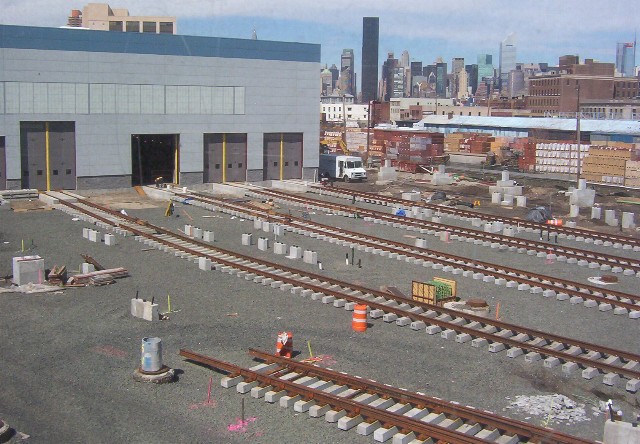Railroad Forums
Ties in Bay shore
- Discussion of the past and present operations of the Long Island Rail Road.
Moderator: Liquidcamphor
by thrdkilr
I was just wondering why it took them so long to come out with concrete ties? It seems so obvious. Was it they figured a way to make it economical? Did they come up with a new kind of cement? As far as durability, Paul, out Cal. way might know, they replaced the ties at Tehachapi about 7 or 8 years ago. There is no better place to test them out, the traffic, the wieght of the trains, and the curves, have got to be the most stessful anywhere!
by Nasadowsk
Ok, we're discussing two distinct issues w.r.t. failure here:
* Manufacturer's defect. I'd imagine if this is the case, then they'll be replaced.
* Lack of maintenance by the LIRR. There's a learning curve with these things. Like everything else. IIRC, isn't the oldest stretch of concrete along the main between Jamacia and Harold? Are there failures being seen there?
I wonder if the LIRR's ever looked at direct fixation - yes, I know there's a few miles of it on causeways on the Babylon branch. I mean, on the ground, as opposed to concrete or wood in areas where it could help. Big bucks, but very nice if done right. Not easy, or for everything.
Amtrak's had concrete for ages, I recall hearing they had big issues with it origionally, too. Maybe it's time to look around the US/Europe to see what everyone's concrete experiences are, and under what conditions, and see what's working and what isn't?
I suspect like everything else, it has a place, but then, for all the talk about concrete breaking, I'm reminded of the trackbed around Mineola station....
* Manufacturer's defect. I'd imagine if this is the case, then they'll be replaced.
* Lack of maintenance by the LIRR. There's a learning curve with these things. Like everything else. IIRC, isn't the oldest stretch of concrete along the main between Jamacia and Harold? Are there failures being seen there?
I wonder if the LIRR's ever looked at direct fixation - yes, I know there's a few miles of it on causeways on the Babylon branch. I mean, on the ground, as opposed to concrete or wood in areas where it could help. Big bucks, but very nice if done right. Not easy, or for everything.
Amtrak's had concrete for ages, I recall hearing they had big issues with it origionally, too. Maybe it's time to look around the US/Europe to see what everyone's concrete experiences are, and under what conditions, and see what's working and what isn't?
I suspect like everything else, it has a place, but then, for all the talk about concrete breaking, I'm reminded of the trackbed around Mineola station....
by Clemuel
I know it's not like Massapequa Park, but the Atlantic Avenue Improvement (1939) from Dunton to East New York is an interesting examination of LIRR direct fixation track. Installed IND Subway style, there are two half-ties with a drainage ditch between them. The ties are set in concrete on steel pins set in the tunnel floor.
Unfortunately 55 years later, the half ties are shrinking, permitting an accummulation of dirt along the outside. This is resulting in tight guage. The LIRR is stumped by the problem. Short of piecemeal replacement with whole ties and the installation of guage bars, the job calls for huge expenditures to correct.
Anyone knows how the subway goes about dealing with this problem?
Clem
Unfortunately 55 years later, the half ties are shrinking, permitting an accummulation of dirt along the outside. This is resulting in tight guage. The LIRR is stumped by the problem. Short of piecemeal replacement with whole ties and the installation of guage bars, the job calls for huge expenditures to correct.
Anyone knows how the subway goes about dealing with this problem?
Clem
by Nasadowsk
I think the way they do it on the NYCTA is a total replacement of the track. Ever see where they've cut away old concrete and put in new? IT's REALLY interesting...
I'm guessing the LIRR's track is built more or less the same was as the NYCTA's down there - they likely got the idea from the IND or IRT or whomever. Does the LIRR and NYCTA ever 'exchange notes' on these things? Or for that matter anything else - I know the NYCTA has been really sucessful with getting rid of shoe beam troubles and a few other things. I'd imagine they'd be interested in the LIRR's concrete tie experiences, too (They run lighter trains but many more of them - makes an interesting tradeoff)
I'm guessing the LIRR's track is built more or less the same was as the NYCTA's down there - they likely got the idea from the IND or IRT or whomever. Does the LIRR and NYCTA ever 'exchange notes' on these things? Or for that matter anything else - I know the NYCTA has been really sucessful with getting rid of shoe beam troubles and a few other things. I'd imagine they'd be interested in the LIRR's concrete tie experiences, too (They run lighter trains but many more of them - makes an interesting tradeoff)
